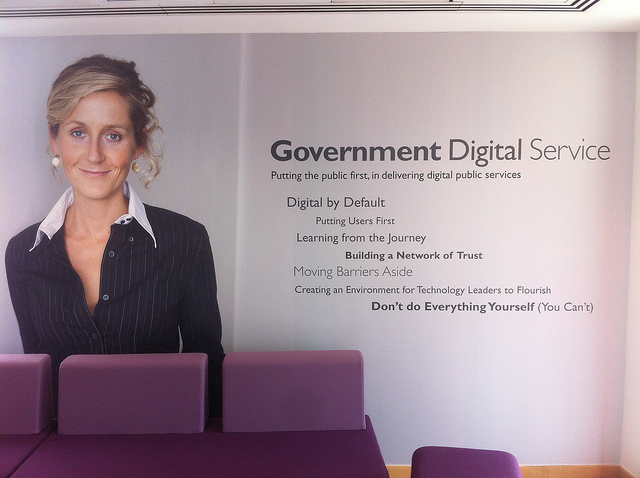Open* Collaboration & Innovation
on
 Open standards, open-source, open data, open government and open dialog. These are just some of the great benefits of the open web and why you should consider getting involved in the Open Source Initiative. It represents a real shift toward transparency that allows citizens to become engaged and can empower civil servants in their everyday work.
Open standards, open-source, open data, open government and open dialog. These are just some of the great benefits of the open web and why you should consider getting involved in the Open Source Initiative. It represents a real shift toward transparency that allows citizens to become engaged and can empower civil servants in their everyday work.
The Open Source Community
In Canada, the biggest success for open thinking was the Web Experience Toolkit. This project engaged existing open source projects like jQuery & Bootstrap to address the challenge of providing a multi-lingual, performant & accessible responsive interface. These are huge communities, with jQuery being used by over 750,000 sites and the Twitter Bootstrap theme is used in over 140,000 sites.
By engaging with these other communities, not only was there an opportunity to share best practices with the world, but also the opportunity to learn from the thousands of people who are also engaged with these large software communities. Although the Government of Canada is a large institution with about 250,000 staff, the open community is much bigger with so much knowledge and commentary to offer.
Innovation Through Interaction
Innovation happens largely through spontaneous collisions. It is through collaboration & interaction with the outside where people find the best ideas. If creative civil servants are kept within a silo, their possible societal impact will be reduced. There is a serious risk of losing a generation of technical people in government who expect to be able to work on meaningful projects.
Most people enter the public service because they believe that it is a way that they can help. Why get in their way?
The Government Service Design Manual (GDS)
Many people in government have heard about the UK’s initiative to reduce the number of government sites to one in order to improve citizen usability. This is the model that we are moving towards with the Government of Canada. Unfortunately, many people are not familiar with the Government Service Design Manual which is the basis of this move. The work that is still being done there actively involves Open* for it’s success.
There is a set of principles gov.uk is using with this bold initiative:
The Original 7 GDS digital principles
Putting the public first, in delivering digital public services
- Digital by default
- Putting users first
- Learning from the journey
- Building a network of trust
- Moving barriers aside
- Creating an environment for technology leaders to flourish
- Don't do everything yourself (you can't)
That list has been expanded on:
- Start with needs (user needs not government needs)
- Do less
- Design with data
- Do the hard work to make it simple
- Iterate. Then iterate again.
- This is for everyone
- Understand context
- Build digital services, not websites
- Be consistent, not uniform
- Make things open: it makes things better
The tenth principle in particular has a quote that speaks volumes of the impact open source community has had on the UK’s initiative. “Much of what we’re doing is only possible because of open source code and the generosity of the web design community. We should pay that back.” There are a lot of other valuable insights from their blog.
GitHub & 18F
This fall when Leisa Reichelt came to speak at CanUX she encouraged us all to go to GitHub and start forking their work. Canadian governments can learn from what has been done, customize it to their needs and also contribute back to a school of thought that puts users first. This involves experimentation, flexibility, and the ability to fail forward.
If Canadian government is going to be digital by default, they need to rethink how the public sector works and foster organizations like 18F in the USA. Like innovators in the UK, this team is actively leveraging GitHub and implementing a Share First approach to innovation. They are able to look at difficult issues like government procurement, which is still a real hurdle for supporting procurement of Open* ideas in government.
Open Source & Open Data
Most people don’t understand the jump between open source and open data, as Steward Brand has said "Information wants to be free". However, the open data movement wouldn’t have happened without both the tools and culture of open source. Many of the best tools to analyse and produce open data are open source. Ensuring that the tools remain open source will be the only way to guarantee that the information is available for everyone and will stand up to an independent audit.
Open data & open source both require a hacker culture to flourish. People need the time to investigate problems & look for broader solutions.
The Way Forward
The mandate letters provided by PM Trudeau were clear for the need to support open, transparent and innovative initiatives. Assuming the government will follow through with these initiatives, the question now becomes: What are we waiting for?
Share this article
About The Author
Mike Gifford is the founder of OpenConcept Consulting Inc, which he started in 1999. Since then, he has been particularly active in developing and extending open source content management systems to allow people to get closer to their content. Before starting OpenConcept, Mike had worked for a number of national NGOs including Oxfam Canada and Friends of the Earth.




Add new comment